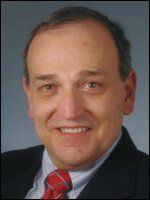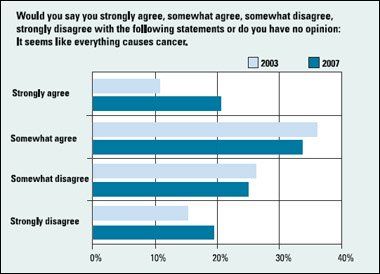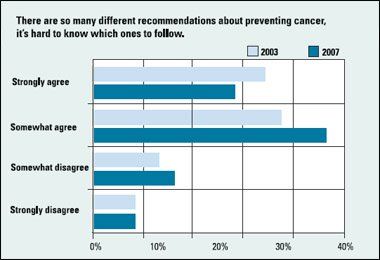Patients look for answers on Web but trust it less
Glut of e-health information has put public in a ‘data smog.’
ABSTRACT: Glut of e-health information has put public in a ‘data smog.’
Sixty million people in the U.S. surf the Web for health information on an annual basis. In a best case scenario, they can walk away from the computer with a clearer understanding of their health problems, an understanding that should lead to improved communication with their physicians. But given the sheer volume of Internet-based health information and the fact that quality control on many sites is haphazard, patients can also come away confused, misinformed, or even frightened.
Fortunately, in cancer care, patients are becoming savvier about the unevenness of oncology-related information on the Web, according to an ongoing NCI survey that tracks where and how patients obtain health information. The Health Information National Trends Survey is designed to provide data every two years on how U.S. adults use the Internet. Thus far, HINTS has surveyed nearly 16,000 people between 2002 and 2008.
According to 2003 figures, 49% of 6,149 respondents said their first stop for information is the Web, followed by print media (27%) and their healthcare provider (11%). But between 2002 and 2008, respondents reported that their trust in information from healthcare professionals had increased while their trust in health information from the Internet had waned (N Engl J Med 362:859-860, 2010).

"Trust may actually be increasing as consumers rely on their physicians to interpret the confusing nature of online information." - BRADFORD W. HESSE, PHD
What are the factors that influence where cancer patients seek information and how much trust they are willing to put in it? Bradford W. Hesse, PhD, chief of the health communication and informatics branch at the NCI's division of cancer control and population sciences, is one of the leaders of HINTS. He outlined the critical issues that affect the way physicians communicate with their patients and what part the Web plays in that conversation.
How does the Internet influence patient-provider communications?
Alarming news stories about the callousness of managed care or malpractice lawsuits run amok have no doubt had a negative effect on patient-physician relationships, but these connections haven't been completely eroded, according to Dr. Hesse.
"Despite a decade's worth of exposure to health information on the Internet, the public's trust in physicians as their preferred source of health information has remained high," he said. "If anything, it has increased. At the same time, trust in health information from the Internet or other sources-friends and relatives, radio, and television-has decreased."
According to HINTS, in 2008, nearly 70% of the respondents said that they trusted their physicians "a lot" vs "a little," compared with 60% in 2003. One reason is that patients rely more and more on their physicians to help them sort out the information they glean on the Web. "Trust may actually be increasing as consumers rely on their physicians to interpret the confusing nature of online information," Dr. Hesse said.
Also, slowly but surely, email is becoming a more common communication channel between patients and doctors, with cancer survivors reaching out most often online. In the 2003 HINTS, 24.4% of online cancer survivors reported that they emailed their doctors, used online support groups, or bought medicines online. That percentage climbed to 34.4% in 2008.
Although most physicians do not give their email addresses to patients, if they are compensated or reimbursed for the time so spent, they are more likely to use that method of communication, Dr. Hesse said.
Is there a digital divide; i.e., an inequality of access?
Not surprisingly, the answer to that question is "yes." Based on HINTS data, this digital divide falls along educational lines: Respondents who reported that they did not graduate from high school had less access to computers and more trouble understanding and interpreting healthcare information.
"Education level is the most important predictor of whether people will go online for health information," Dr. Hesse said. "The higher the education level, the more likely people will know how to distinguish among websites regarding their quality."
Income and age also make a difference. In 2008, a little over 80% of respondents reporting an income of at least $75,000 used the Internet to look for medical information.
Also in 2008, nearly 80% of respondents ages 18-34 used the Web most often for medical information. There was a slight drop-off to 70% for ages 34-64 and then a significant drop to about 30% for those 65 and older.
Is the public's understanding of healthcare improving? Will e-health tools help clear up this confusion?
Figure 1: Confusion over causes of cancer

Data from HINTS 2003-2007, NCI division of cancer control and population sciences DCCPS and the health communication and informatics branch. Graphic courtesy of Dr. Hesse.
Most of us live in what's been dubbed "data smog," where we are inundated with so much information it can sometimes be easier to ignore it than acknowledge it and try to sort it all out.
HINTS asked respondents a series of questions about their perception of cancer and cancer news. In general, those surveyed agreed with statements such as "It seems like everything causes cancer" and "There are so many different recommendations about preventing cancer, it's hard to know which ones to follow" (see Figures 1 and 2).
Figure 2: Confusion over cancer prevention recommendations

Data from HINTS 2003-2007, NCI division of cancer control and population sciences DCCPS and the health communication and informatics branch. Graphic courtesy of Dr. Hesse.
As for e-health, the number and variety of personal assistance applications for patients to track their own health have increased markedly in the past few years. People can now have personally tailored diet and exercise programs, and there are myriad sources for information on cancer prevention, Dr. Hesse said.
But it remains to be seen if people will use these resources consistently and intelligently, he added.
Dr. Hesse and colleagues recently published a report asking: Will information technology be a viable intervention to improve the quality of cancer care? They suggested that e-health "applications that emphasize cognitive support for prevention recommendations and that encourage patient engagement can help create a coordinated healthcare environment conducive to cancer prevention and early detection" (Natl Cancer Inst Monogr 2010:81-89, 2010).
References:
Source:
2010 National Cancer Institute Science Writers’ Seminar. Additional reporting by Shalmali Pal.